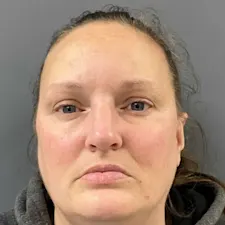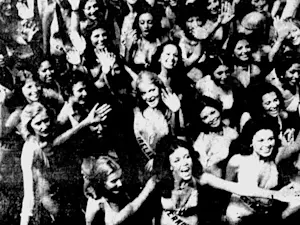
Who Was the 'Dating Game Killer'? The Disturbing Story Behind Rodney Alcala
Serial killer Rodney Alcala's 1979 mugshot. Photo courtesy of the Huntington Beach Police Department. Public domain.
Rodney Alcala, later dubbed the "Dating Game Killer," shocked America not only for his chilling murders but also for his brazen appearance on the popular TV show "The Dating Game" in 1978. While Alcala's charming persona won him a date on national television, his public appearance was an eerie contradiction to his horrific acts. Let's explore Alcala's sinister background, his twisted pursuit of fame, and the enduring impact on his survivors.
A Troubled Start: Alcala's Early Life and Military Discharge
Rodney Alcala was born in San Antonio, Texas, in 1943. His early life was marked by instability, as his father abandoned the family when Alcala was young. At 17, he enlisted in the Army, seeking structure and purpose, but this attempt quickly unraveled. Alcala soon faced allegations of sexual misconduct, and he suffered a nervous breakdown. In 1963, the Army discharged him, with officials concluding that his behavior reflected a dangerous pattern. According to CBS News, former NYPD cold case detective Steve Braccini remarked that by then, the military had recognized Alcala as a "sexual deviant," marking the beginning of a disturbing trajectory.
The Double Life of Rodney Alcala
Alcala's crimes, hidden beneath a façade of charisma and intelligence, spanned decades and multiple states. Initially convicted in the 1970s, Alcala's string of violent attacks and murders haunted families and communities across the U.S. He preyed on young women and girls, using his photography to lure them into vulnerable situations. Alcala's crimes remained hidden until authorities connected him to a series of brutal murders.
A Killer Seeks the Spotlight
In 1978, Alcala's appearance on "The Dating Game" remains one of the most shocking aspects of his story. His calculated decision to participate, despite being an active predator, raises questions about his motivations. Psychologists suggest that the thrill of fame and a sense of invincibility often drive serial killers to seek public attention. Alcala's time on television highlighted this twisted need, as he not only appeared relaxed and charming, but he even won the date. His brief brush with stardom, however, ultimately contributed to his downfall as investigators later identified him as a suspect.
A Trail of Tragedy: Alcala's Confirmed Victims and Final Fate
Rodney Alcala is suspected of killing up to 130 people, though he was only convicted of seven murders committed between the late 1960s and the 1970s across California and New York. In 1979, Alcala was arrested for the murder of 8-year-old Robin Samsoe and was convicted in California in 1980 for her death. He was also found guilty of killing Jill Barcomb, 18; Jill Parenteau, 21; Georgia Wixted, 27; and Charlotte Lamb, 32, in California. In addition, he was convicted of the murders of Cornelia Michael Crilley, 23, and Ellen Hover, 23, in New York.
Detective Steve Hodel reflected on Alcala's deceptive charm, saying, "He was a snake charmer. I went and talked to his professor at UCLA ... he says Rod Alcala wouldn't hurt anybody. He's a great guy. He truly believed that, you know. And — a lot of people did," as reported by CBS News. Hodel's statement highlights how Alcala's charisma allowed him to manipulate those around him, presenting himself as a friendly, harmless individual despite his disturbing actions. This facade of normalcy contributed to his ability to evade suspicion, allowing him to hide his violent nature behind a carefully crafted public persona.
 1971 FBI Wanted Poster of Alcala. Photo courtesy of the FBI. Public domain.
1971 FBI Wanted Poster of Alcala. Photo courtesy of the FBI. Public domain.
Rodney Alcala's Timeline:
-
1968: Alcala brutally assaulted and attempted to kill 8-year-old Tali Shapiro in Los Angeles. He fled to avoid arrest, relocating to New York where he enrolled into NYU Film school, assuming the alias to avoid detection.
-
1969: FBI put Rodney Alcala on its Most Wanted List.
-
1971: Alcala murdered 23-year-old Cornelia Michael Crilley in New York, then fled to New Hampshire, where he worked as a camp counselor under the alias "John Berger." His cover was blown when two girls recognized him from a wanted poster, leading to his arrest and extradition to California. There, he pleaded guilty to sexual assault of Tali Shapiro, receiving only a 34-month prison sentence after her parents declined to let her testify.
-
1977: After serving time, Alcala returned to New York, where he used his alias to murder 23-year-old Ellen Hover. On the day she vanished, she had noted a date with "John Berger" on her calendar. Her body was discovered a year later, finally linking Alcala to her disappearance.
-
1978: Back in California, Alcala carried out a series of brutal murders, targeting young women like Jill Barcomb, 18; Georgia Wixted, 27; Charlotte Lamb, 32; and Jill Parenteau, 21. His killings were marked by extreme violence, yet he managed to evade detection. Astonishingly, during this period, he even appeared on "The Dating Game."
-
1979: Alcala murdered Robin Samsoe in California, marking one of his most widely publicized crimes. This murder ultimately led to his capture as authorities identified him as the primary suspect.
-
1980: After his arrest, Alcala was convicted in California for the murder of Samsoe, as well as the murders of Barcomb, Wixted, Lamb, and Parenteau. Later investigations connected him to the murders of Crilley and Ellen Hover, in New York, leading to further convictions.
Rodney Alcala was convicted of seven murders and faced five separate death sentences, but he died of natural causes in July 2021 at the age of 77 while awaiting execution. Some of his intended victims survived his brutal attacks, providing critical testimonies that helped secure his conviction and shed light on his violent tendencies, linking him to several unsolved cases.
The Survivors: Lives Forever Changed
The impact of Rodney Alcala's actions has left enduring scars on his victims and their families. Many survivors and their loved ones continue to confront the trauma he inflicted, haunted by memories of his manipulative nature and brutal violence. In recent years, these survivors have courageously shared their stories, shedding light on the deep and lasting impact of Alcala's crimes. Their voices are vital to understanding the true horror of his legacy and the pain he left behind.
Alcala's disturbing story and his ability to deceive even under public scrutiny have been revisited in the recent Netflix® film "Woman of the Hour," directed by and starring Anna Kendrick. The film explores his chilling double life and captures the darkness lurking behind his charismatic facade on "The Dating Game," ensuring that the cautionary lessons of his story are not forgotten.
References: Where Are Survivors of Rodney Alcala Now? | Why Serial Killers Like Rodney Alcala Seek the Spotlight on TV — Despite Risk of Getting Caught | Serial Killer Rodney Alcala's Trail of Murder























